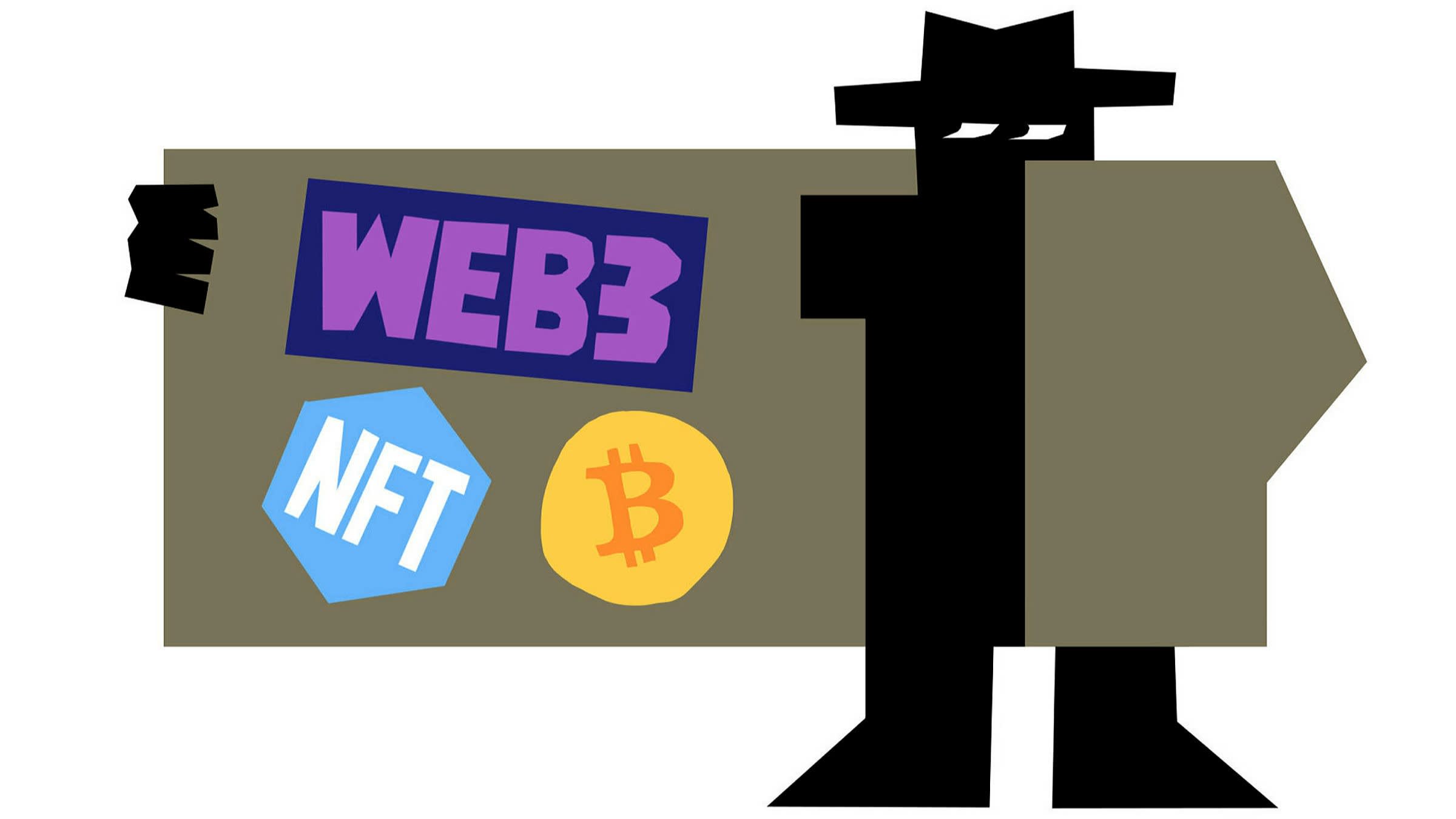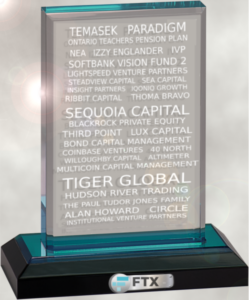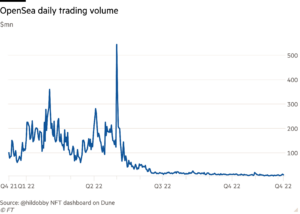
You have probably, unless you’ve been unusually fortunate, been schooled in the wonders of Web3. For the remaining lucky few, allow me to explain. Web3 is the inexorable destiny of the internet — the magical fabric from which blockchain-based decentralised dreams are made and dystopian big-tech nightmares destroyed. The future is bright; the future is “append-only” databases.
The central thesis of Web3 is that because the internet has become so centralised — with power concentrated in the hands of a few, and users powerless over their own data — we need a more distributed, egalitarian, open system. So far, so reasonable.
But the minute you look beneath the surface, gaping holes appear in the Web3 vision. Its techno-utopian advocates say they want to harness the alleged power of blockchains — the immutable databases that underpin bitcoin and other tokens — to create a democratised internet where you control your own data and are no longer reliant on the big tech giants. Web3, the argument goes, will allow you to “own a piece of the internet”. Naturally, the “decentralised” apps and organisations that operate in this brave new world are powered by crypto tokens: all you need to do is buy them.
In truth, Web3 has become just the latest marketing term used to try to prop up and repackage the overlapping ideas of crypto, non-fungible tokens, and “decentralised finance”, which all seemed brilliant innovations until the whole market started to tank. No matter that blockchain — once touted as the solution to everything from corrupt elections to supply-chain fraud — has totally failed to live up to the hype and only proved its usefulness as the enabler of the crypto casino. This time will be different.
It is hard to even discuss Web3 because it is, like many similar overhyped concepts, a very nebulous term. I had a somewhat heated exchange last weekend with someone who claimed that Web3 was about banks processing data to predict your divorce and downgrade your credit rating before you realise your spouse is having an affair. That, I argued, was about Big Data and artificial intelligence, which has nothing to do with blockchains or distributed ledgers. But just like the metaverse and the “Fourth Industrial Revolution” before that, Web3 often seems to be used to mean something along the lines of “techy stuff that could do stuff in the future”.
The term itself comes from the idea that we have had two iterations of the web: the first, launched in the early 90s, lasted for just over a decade and consisted mainly of static web pages that were not interactive. The second, arriving in the early 2000s and continuing to this day, allowed users to upload their own content to the web, but in so doing, the user unwittingly became the product.
Perhaps the most disingenuous and pernicious aspect of Web3 is the lie that it is truly about decentralisation. Its biggest backers are Andreessen Horowitz — or a16z — a venture capital firm with billionaire co-founders and assets under management of more than $28bn, which launched a $4.5bn Web3 fund earlier this year. Leaving aside the fact that launching a multi-billion-dollar fund seems like quite some concentration of wealth, this firm also happens to be a major Web2 investor: it has, for instance, a stake in Meta, formerly known as Facebook, on whose board a16z co-founder Marc Andreessen still sits.
“Power . . . is just becoming re-centralised in the hands of a small few other investors, in some cases the same exact people who hold so much power in the current web,” according to Molly White, a software engineer and author of the “Web3 Is Going Just Great” blog, who is one of Web3’s leading critics. “I do think there are ways to achieve decentralisation on the internet,” she tells me. “But I see those solutions necessarily as being based in societal and policy change rather than in pure technological change.”
Meanwhile, firms like a16z-backed crypto exchange Coinbase — which, until recently, was raking in hundreds of millions of dollars’ worth of profits every quarter — are positioning themselves to be “the default gateway to the Web3 ecosystem”. Rather strange that an internet that is all about openness and decentralisation would need a corporate behemoth to provide entry.
Web3 is not about making the internet fairer or less liable to exploitation by greedy fat cats, it’s actually the very opposite: it’s about introducing yet another layer of financialisation to the web. The reality, therefore, is actually far more simple than the jargon you will have to sit through when someone is explaining it to you. Web3 is just the newest way of serving up the same old crypto bullshit, and it stinks just as badly as ever.
- SEO Powered Content & PR Distribution. Get Amplified Today.
- PlatoAiStream. Web3 Data Intelligence. Knowledge Amplified. Access Here.
- Minting the Future w Adryenn Ashley. Access Here.
- Buy and Sell Shares in PRE-IPO Companies with PREIPO®. Access Here.
- Source: https://www.ft.com/content/bb53f8d8-a4bc-4ab0-8a81-e8befe7e31d1
- :has
- :is
- :not
- :where
- $UP
- a
- a16z
- About
- According
- Achieve
- actually
- advocates
- All
- alleged
- allow
- along
- also
- an
- and
- Andreessen
- Andreessen Horowitz
- Another
- appear
- apps
- ARE
- argument
- arriving
- artificial
- artificial intelligence
- AS
- aspect
- Assets
- author
- backers
- badly
- Banks
- based
- Battle
- BE
- became
- because
- become
- becoming
- been
- before
- behemoth
- being
- Big
- Big Data
- big tech
- Biggest
- billionaire
- Bitcoin
- blockchain
- blockchain-based
- blockchains
- Blog
- board
- brave
- Bright
- brilliant
- but
- buy
- by
- capital
- cases
- Casino
- Cats
- central
- change
- claimed
- Co-founder
- co-founders
- coinbase
- COM
- comes
- Concentrated
- concentration
- concepts
- content
- continuing
- control
- Corporate
- could
- create
- credit
- credit rating
- Critics
- crypto
- crypto casino
- crypto exchange
- crypto exchange Coinbase
- CRYPTO TOKENS
- Current
- data
- databases
- day
- decade
- decentralisation
- decentralised
- Default
- destroyed
- different
- discuss
- distributed
- distributed ledgers
- do
- doing
- Downgrade
- dreams
- dystopian
- Earlier
- Early
- Elections
- engineer
- entry
- Even
- Every
- everything
- exchange
- Explain
- explaining
- exploitation
- fabric
- Failed
- far
- Fat
- few
- Firm
- firms
- First
- For
- formerly
- fortunate
- fraud
- fresh
- from
- FT
- fund
- future
- gateway
- Goes
- going
- Greedy
- had
- Hands
- happens
- Hard
- Have
- having
- hold
- Holes
- Horowitz
- HTTPS
- Hundreds
- hundreds of millions
- Hype
- i
- idea
- ideas
- immutable
- in
- industrial
- innovations
- instance
- Intelligence
- interactive
- Internet
- introducing
- investor
- Investors
- IT
- iterations
- ITS
- itself
- jargon
- jpg
- just
- known
- Last
- latest
- launched
- launching
- layer
- leading
- leaving
- ledgers
- less
- like
- lines
- LINK
- live
- longer
- Look
- made
- mainly
- major
- Making
- management
- many
- Market
- Marketing
- Matter
- mean
- Meta
- Metaverse
- millions
- minute
- Molly White
- more
- most
- much
- necessarily
- Need
- New
- Newest
- no
- non-fungible
- non-fungible tokens
- nothing
- of
- often
- Old
- on
- once
- ONE
- ongoing
- only
- open
- Openness
- operate
- opposite
- or
- Organisations
- Other
- over
- own
- People
- piece
- plato
- Plato AiStream
- Plato Data Intelligence
- PlatoAiCast
- PlatoData
- policy
- positioning
- power
- powered
- predict
- probably
- processing
- Product
- profits
- proved
- provide
- Quarter
- rather
- rating
- Reality
- reasonable
- recently
- remaining
- same
- say
- Second
- see
- seemed
- seems
- serving
- she
- similar
- Simple
- sits
- small
- So
- so Far
- societal
- Software
- Software Engineer
- solution
- Solutions
- some
- Someone
- something
- somewhat
- stake
- started
- Still
- Surface
- system
- tech
- tech giants
- technological
- tells
- than
- that
- The
- The Future
- The Metaverse
- their
- Them
- themselves
- There.
- therefore
- thesis
- they
- think
- this
- this year
- those
- Through
- time
- to
- Tokens
- TOTALLY
- touted
- true
- truly
- truth
- two
- under
- until
- used
- User
- users
- venture
- venture capital
- very
- Video
- vision
- want
- was
- Way..
- ways
- we
- Wealth
- web
- Web2
- Web3
- Web3’s
- weekend
- were
- when
- which
- white
- WHO
- whole
- will
- with
- world
- worth
- would
- year
- yet
- you
- Your












